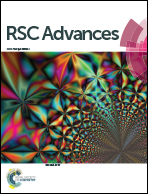CdTe QD-based inhibition and reactivation assay of acetylcholinesterase for the detection of organophosphorus pesticides†
Abstract
An enzyme immobilized glutathione (GSH)-capped CdTe quantum dot (QD)-based fluorescence assay has been developed for monitoring organophosphate pesticides. In principle, GSH-capped CdTe QDs exhibit higher sensitivity towards H2O2 produced from the active enzymatic reaction of acetylcholinesterase (AChE) and choline oxidase (CHOx), which results in the fluorescence (FL) “turn-off” of the GSH-capped CdTe QDs. A “turn-on” FL of the CdTe QDs at 520 nm was recovered in the presence of organophosphate (OP). The FL changes of the GSH-capped CdTe QD/AChE/CHOx biosensor reasonably correspond to the amount of OP pesticides. The detection limit of the CdTe/AChE/CHOx biosensor towards paraoxon, dichlorvos, malathion and triazophos was 1.62 × 10−15 M, 75.3 × 10−15 M, 0.23 × 10−9 M and 10.6 × 10−12 M, respectively. The GSH-capped CdTe QDs/AChE/CHOx biosensor was applied as a FL nanoprobe for assaying the enzymatic activity of AChE. The inhibited AChE was reactivated up to 94% using pyridine oximate (2-PyOx−), and functionalized pyridinium oximates (4-C12PyOx− and 4-C18PyOx−) of varying chain lengths. It was found that the reactivation potency of the tested oximes varied with the chain length of the oximes. This biosensing system offers the promising benefit for the determination of the OP pesticides in food, water and environmental samples.

- This article is part of the themed collection: Detection of contaminants in food


 Please wait while we load your content...
Please wait while we load your content...